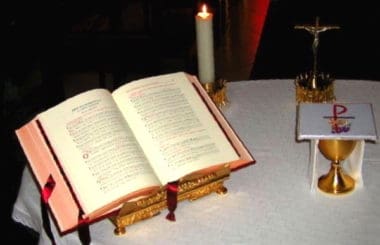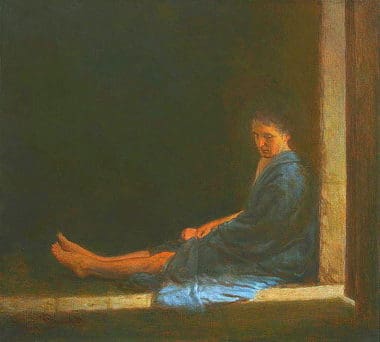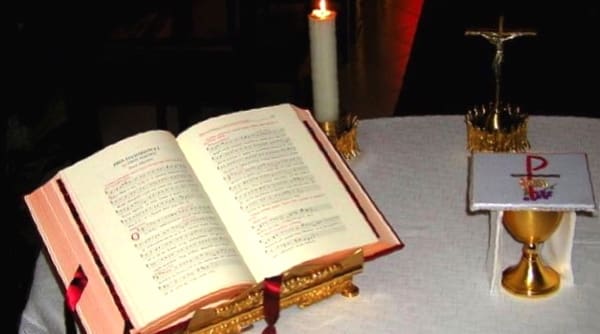The Need for a Liturgical Conscience—and Where to Get One
(Part I of III)
Guitar choir or Gregorian Chant? Communion on the tongue or in the hand? Liturgical language that is elevated, formal, and Latinate—as in the present Roman Missal—or language more common, casual, and conversational—as in the former  Sacramentary?
Sacramentary?
Opinions on liturgical matters such as these differ, as with myriad other liturgical elements – Is the Church better served by modern or traditional architecture? Should the Easter Vigil begin late for the sake of symbolic darkness or early to encourage better attendance? Ought Christmas poinsettias be real or silk?
Parish liturgical committees debate such issues and render advice to their pastors. But on what grounds? To what degree does one’s own personal preference—whether one sits on the liturgy committee or in the pew—determine what is “good” or “bad” in the liturgy? Am I my own liturgical litmus?
Pope John Paul II once asked this same question:
“The Liturgy! Everybody speaks about it, writes about it, and discusses the subject. It has been commented on, it has been praised, and it has been criticized. But who really knows the principles and norms by which it is to be put into practice? The Constitution Sacrosanctum Concilium referred to the liturgy as the ‘source’ and the ‘summit’ of the Church’s life (no.10): what is being done to make this sublime definition a reality?”[i]
Indeed: who does know the standards by which the liturgy is celebrated and evaluated? Moreover, where are these measures to be found?
In his questions about liturgy cited above, John Paul II has revealed their answer: the Magisterium’s Constitution on the Sacred Liturgy, Sacrosanctum Concilium.
In preparation for the Third Christian Millennium, as well as on the 40th Anniversary of Council’s liturgical constitution, Pope John Paul spoke of an “examination of conscience” similar to one Catholics would make prior to sacramental confession.[ii] Prior to the Sacrament of Penance, I am called to examine my moral life—my thoughts and words, my commissions and omissions—according to the Commandments, the Word of God, and the teaching of the Church.
A Liturgical Conscience
Along those same lines, a liturgical conscience—of an individual, a committee, a parish, or even the Church universal—is also formed and judged according to received norms. Some of these norms are revealed while others are put forward by the Magisterium.
 But whether the subject is liturgy or morality, the temptation is the same, namely, to be our own rule—and ruler. But this is impossible. While a conscience is often described as an “interior voice,” one rising from deep within, a conscience is at the same time a voice from without, a law inscribed by God himself.[iii]
But whether the subject is liturgy or morality, the temptation is the same, namely, to be our own rule—and ruler. But this is impossible. While a conscience is often described as an “interior voice,” one rising from deep within, a conscience is at the same time a voice from without, a law inscribed by God himself.[iii]
Etymologically, “conscience” means “to know” (from the Latin scio) “with others” (con). This “other” is the Church, and a well-formed liturgical conscience—as St. John Paul II suggests—is formed and examined according to the Church’s own liturgical principles.
What are the “principles and norms”—let’s call them Commandments—of the liturgical life? The Second Vatican Council’s Constitution on the Sacred Liturgy, when read in light of the Church’s tradition and understood according to her liturgical life, gives the Church’s liturgy its direction. And while not exactly laid out as a litany of positive or negative proscriptions such as Moses received on Sinai, the Constitution’s contents might be distilled into a decalogue of liturgical formation and decision-making. (In fact, John Paul II himself performs such an examination of conscience concerning the Church’s liturgical and sacramental life in his 2003 Apostolic Letter Spiritus et Sponsa.)
+
[i] Address to the participants in the plenary meeting of the Congregation for Divine Worship and the Discipline of the Sacraments, October 17, 1985.
[ii] See Tertio Millennio Adveniente, ‘On Preparation for the Jubilee of the Year 2000,” 36 and Spiritus et Sponsa, “On the 40th Anniversary of the Constitution on the Sacred Liturgy, Sacrosanctum Concilium,” 6.
[iii] See Catechism of the Catholic Church, 1776 and following.
+
Editor’s Note: In Part II, Christopher Carstens will address the first five of the 10 Commandments of the Liturgical Life.
+
Art for this post on The Need for a Liturgical Conscience: Missale Romanum, photographed by Lima, 24 September 2006, CCA-SA 2.5 Generic; mirror of The Conscience, Andrey Mironov, 2015 own work, CCA-SA 4.0 International; both Wikimedia Commons.




